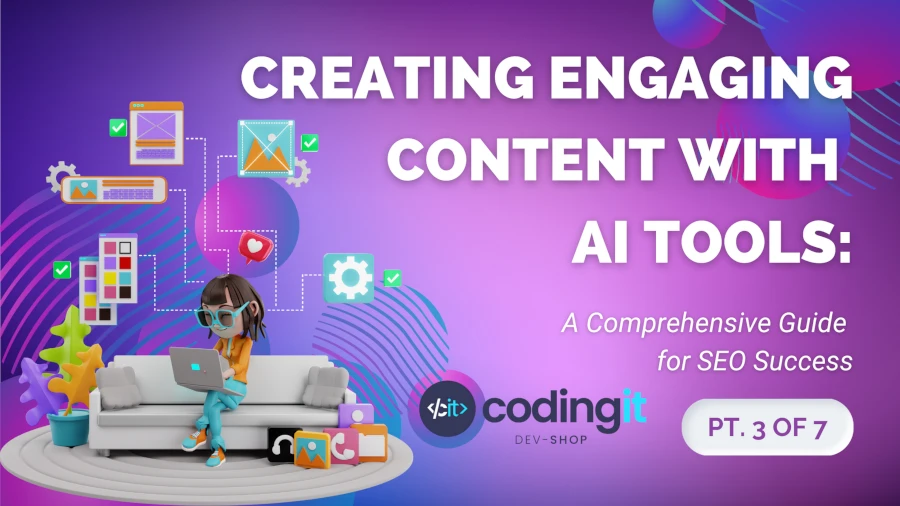Content creation has emerged as a pivotal element in the success of marketing and branding efforts. However, with the ever-increasing competition for online visibility, businesses must find ways to stand out amidst the noise and connect with their audience on a deeper level. This is where the power of artificial intelligence (AI) comes into play.
AI has revolutionized numerous industries, and content creation is no exception. By leveraging AI tools, businesses can unlock a world of possibilities, enabling them to create compelling, relevant, and SEO-friendly content that resonates with their audience. This article is designed to equip you with the knowledge and skills to harness the immense potential of AI in content creation.
By following the comprehensive guidance provided in this series of articles, this is only part 3 of the 7 part series, you will gain a deeper understanding of AI-powered content creation and its immense potential for driving organic traffic and user engagement. Equipped with practical knowledge and valuable insights, you will be empowered to leverage AI tools to create compelling and optimized content that sets you apart in the hyper-competitive digital landscape.
Now, let’s begin exploring the world of AI-powered content creation and unlocking the opportunities it holds!
- Preparing AI Models for Optimal Performance
Preparing AI Models for Optimal Performance
Understanding AI Training Data and Its Importance
In the realm of AI, training data forms the foundation of model development and performance. It is essential to understand the significance of high-quality and diverse training data to ensure optimal performance of AI models in content creation.
Training data serves as the input for AI algorithms to learn patterns, make predictions, and generate content. It is crucial to curate training data that accurately represents the desired output and covers a wide range of scenarios. For example, if you are training an AI model to generate marketing copy, the training data should include diverse examples of effective marketing language, encompassing different industries, product types, and target audiences.
To ensure the quality of training data, it is advisable to source data from reliable and reputable sources. Consider using established datasets or crowdsourcing platforms that provide access to a diverse range of samples. Furthermore, perform data preprocessing to eliminate noise, outliers, or irrelevant information that could hinder the learning process.
Remember that training data should be regularly updated to reflect the evolving trends and preferences of your target audience. As new patterns emerge, collecting and incorporating fresh data into your AI models can enhance their accuracy and relevance.

Data Preparation Techniques for AI Models
Preparing data for AI models involves several techniques aimed at optimizing their performance and minimizing potential biases. These techniques help enhance the quality of training data and ensure that AI models generate content that aligns with your objectives.
Evaluation Metrics
When evaluating the performance of AI models in content creation tasks, it is essential to utilize appropriate evaluation metrics. These metrics provide insights into how well the models are performing and allow for comparisons between different models or iterations. Common evaluation metrics in content creation tasks include:
- Accuracy: Measures the overall correctness of the AI model’s predictions.
- Precision: Calculates the proportion of true positive predictions out of all positive predictions, indicating the model’s ability to minimize false positives.
- Recall: Calculates the proportion of true positive predictions out of all actual positives, indicating the model’s ability to minimize false negatives.
- F1 score: A combination of precision and recall, providing a balanced measure of model performance.
- BLEU score (for text generation tasks): Evaluates the quality of generated text by comparing it to human-generated references.
Understanding how these metrics are calculated and their interpretation is crucial for assessing and comparing the effectiveness of AI models in content creation tasks.
Model Interpretability
Model interpretability refers to the ability to understand and explain the decisions made by AI models. In content creation, having interpretable models can help identify potential biases, explain model outputs, and ensure transparency. Several techniques can aid in model interpretability:
- Attention mechanisms: These mechanisms highlight the important parts or features of the input data that influenced the model’s decision, providing insights into the decision-making process.
- Saliency maps: Visual representations that indicate the regions or elements in an image or text that the model focused on while making predictions.
- Feature importance analysis: Identifying the most influential features or attributes in the input data that contribute to the model’s decision.
By utilizing these techniques, content creators can gain a better understanding of how AI models generate content and make informed decisions regarding potential biases or areas for improvement.

Fine-Tuning AI Models for Specific Use Cases
While pre-trained AI models provide a strong starting point, fine-tuning them for specific use cases is crucial to maximize their effectiveness in content creation. Fine-tuning involves training the pre-existing models on domain-specific data to adapt them to your specific objectives and requirements.
Start by selecting the most suitable pre-trained model that aligns with your content creation needs. For example, if your goal is to generate product descriptions, you might choose a pre-trained model that has been trained on e-commerce or marketing-related data.
Once you have selected a pre-trained model, fine-tune it using your domain-specific data. This involves providing the model with examples and labeled data that are relevant to your content objectives. By exposing the model to domain-specific patterns and examples, it learns to generate content that is tailored to your specific use case.
Continual Learning and Adaptability
Continual learning and adaptability are vital aspects of AI model development. Content creators should understand techniques that allow models to learn and improve over time as new data becomes available or new trends emerge. Some techniques to consider include:
- Online learning: Updating the model in real-time as new data arrives, allowing it to adapt to changing circumstances and improve its performance incrementally.
- Transfer learning: Leveraging knowledge from one domain or task to another, enabling the model to learn faster and perform well with limited labeled data in the target domain.
- Active learning: Involving human experts in the model training process to select the most informative and representative samples for labeling, optimizing the learning process and reducing annotation costs.
By incorporating these techniques, content creators can ensure their AI models stay up-to-date and continue to deliver accurate and relevant content as new information becomes available.
Collaboration and Human-in-the-Loop
Content creation using AI models can greatly benefit from collaboration between humans and machines. Integrating human feedback and leveraging human creativity alongside AI-generated content can lead to more nuanced and high-quality outputs. Consider the following approaches:
- Human feedback integration: Collecting feedback from users and subjecting the AI-generated content to human review can help improve its quality, ensure it aligns with ethical standards, and address potential biases.
- Leveraging human creativity: AI models can assist human creators by generating initial drafts or providing suggestions, which humans can then refine and enhance, leveraging their creative expertise.
- Symbiotic relationship: Establishing a symbiotic relationship between humans and machines, where each complements the strengths of the other, can lead to more effective and engaging content creation.
By fostering collaboration and incorporating human-in-the-loop approaches, content creators can harness the combined capabilities of humans and AI to produce content that is both accurate and resonates with their target audience.

Overcoming Bias and Ethical Considerations
As with any AI application, content creation with AI tools raises important ethical considerations, particularly regarding bias. Bias can inadvertently be introduced into AI models if the training data reflects societal biases or if there are imbalances in the representation of different groups within the data.
Bias Analysis and Mitigation
Thorough bias analysis and mitigation are crucial to address potential biases in AI-generated content. Content creators should perform a comprehensive examination of the training data to identify biases related to gender, race, socioeconomic factors, or other sensitive attributes. Some steps to consider include:
- Balancing representation: Ensure that the training data includes adequate samples from different groups, preventing the AI models from being biased towards dominant categories and enabling them to generate balanced and representative content.
- Fairness-aware training techniques: Adjust the training process to ensure equal treatment and accuracy across different demographic groups. Techniques such as adversarial training or regularization methods can help mitigate biases in AI-generated content.
Transparency and Explainability
Transparency and explainability are essential for addressing ethical concerns in AI content creation. Documenting the data sources, preprocessing steps, and fine-tuning processes used in your AI models allows for external scrutiny and accountability. It enables stakeholders to understand how decisions are made and identify potential biases or ethical issues.
Performance Evaluation and Human Review
Regularly auditing and evaluating the performance of AI models is crucial to identify and rectify any biases that may emerge overtime. Continuously gathering feedback from users and subjecting the AI-generated content to human review ensures that it aligns with ethical standards and meets the desired quality criteria. By combining automated evaluation metrics with human judgment, content creators can ensure that AI-generated content is not only accurate but also ethically sound.
By proactively addressing bias and considering ethical implications, content creators can harness the power of AI in content creation while promoting fairness, inclusivity, and responsible AI practices. Understanding evaluation metrics, achieving model interpretability, embracing continual learning and adaptability, and incorporating collaboration with humans can further enhance the value and effectiveness of AI models in content creation.
Conclusion
In conclusion, preparing AI models for optimal performance in content creation requires careful consideration of various factors. Understanding the importance of high-quality and diverse training data, employing data preparation techniques, fine-tuning models, and addressing bias and ethical considerations are key steps towards achieving desired outcomes.
Evaluation metrics help assess and compare the effectiveness of AI models in content creation tasks. Model interpretability techniques aid in understanding the decision-making process, identifying biases, and ensuring transparency. Continual learning and adaptability ensure that AI models stay up-to-date and responsive to changing trends. Collaboration and human-in-the-loop approaches enable the combination of human creativity and AI capabilities, leading to more refined content.
Addressing bias and ethical considerations is of utmost importance. Thorough bias analysis, fairness-aware training techniques, transparency, and explainability ensure the ethical use of AI in content creation. Regular performance evaluation and human review help maintain quality standards and mitigate biases.
As content creators strive to produce engaging and SEO-friendly content, the next article, “Crafting Engaging and SEO-Friendly Content,” will delve into strategies and techniques for creating content that captivates audiences while optimizing search engine visibility. By combining the insights gained from preparing AI models with effective content crafting techniques, content creators can maximize the impact and reach of their content.
With a comprehensive understanding of preparing AI models and the knowledge to craft engaging and SEO-friendly content, content creators can unlock the full potential of AI in content creation and deliver exceptional results.
